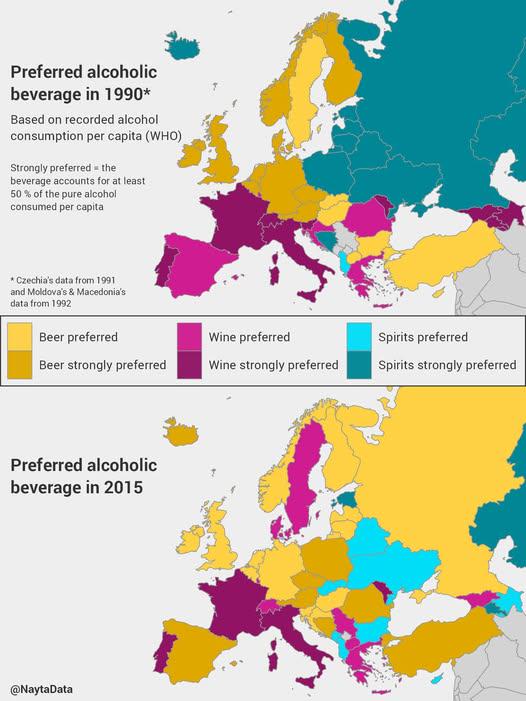Map of Preferred Alcoholic Beverage in Europe 1990 vs 2015


Alex Cartwright
Senior Cartographer & GIS Specialist
Alex Cartwright is a renowned cartographer and geographic information systems specialist with over 15 years of experience in spatial analysis and data...
Geographic Analysis
What This Map Shows
The map titled "Preferred Alcoholic Beverage in Europe: 1990 vs 2015" provides a fascinating snapshot of changing drinking preferences across the continent over a 25-year period. It highlights how different alcoholic beverages—such as beer, wine, and spirits—have gained or lost popularity in various European countries. By comparing two distinct years, the map illustrates shifts in cultural norms, economic conditions, and social habits related to alcohol consumption.
Deep Dive into Alcoholic Beverage Preferences
Alcohol consumption is not merely a matter of personal choice; it reflects deeper cultural, historical, and economic contexts. In Europe, the preference for specific types of alcoholic beverages varies significantly from one country to another, influenced by traditions, production methods, and even marketing strategies.
In 1990, beer was predominantly favored in Northern and Central European countries, such as Germany and the Czech Republic, where the brewing tradition is deeply rooted. Interestingly, while beer remains popular, wine consumption has surged in many Mediterranean regions, such as Italy and Spain. The cultural significance of wine in these countries often goes beyond mere enjoyment; it’s intertwined with culinary practices and social gatherings.
Conversely, spirits have traditionally held a strong position in Eastern Europe. Vodka, for example, is not only a staple in countries like Russia and Poland but also a symbol of national identity. However, between 1990 and 2015, a noticeable shift occurred. Increasing health awareness and shifts in lifestyle choices led to a decline in spirit consumption in certain areas, while wine and beer gained ground.
According to the World Health Organization, the overall alcohol consumption in Europe has seen fluctuations, with a reported decrease in per capita consumption in some regions. This trend might be attributed to a growing emphasis on health and wellness and the rise of alcohol-free alternatives, which are becoming increasingly popular among younger generations.
Regional Analysis
Examining the map reveals distinct regional patterns. In Western Europe, countries like France and Italy have maintained a strong preference for wine, with France consistently ranking as one of the top wine producers in the world. However, a shift is visible in the data, with an increase in beer consumption, particularly among younger demographics, who are drawn to craft beers and unique brewing styles.
In Scandinavia, where beer has been the long-standing favorite, there was a notable rise in wine consumption by 2015. This shift aligns with broader European trends toward wine and reflects changing social dynamics, including increased travel and globalization, which expose residents to diverse drinking cultures.
Eastern European countries, such as Hungary and Poland, continue to show strong preferences for spirits, but the map indicates a slight decline in vodka consumption. This could suggest a generational shift with younger consumers opting for cocktails and other mixed drinks, potentially influenced by social media trends and the burgeoning cocktail culture.
Interestingly, in the UK, the map depicts a significant rise in wine consumption, which may reflect changes in drinking habits and the increasing popularity of wine bars. The rise of wine tastings and festivals has also contributed to this trend, suggesting that cultural activities often drive beverage preferences.
Significance and Impact
Understanding the changing preferences for alcoholic beverages across Europe is more than just a reflection of taste; it speaks to broader societal shifts. This topic matters not only for beverage producers but also for public health policymakers, as drinking habits directly impact societal health outcomes.
With Europe facing challenges related to alcohol-related harm, such as liver diseases and accidents, these trends highlight the need for targeted public health strategies. For instance, the declining consumption of spirits in some regions could be a positive sign of changing attitudes towards alcohol.
Looking ahead, the future of alcoholic beverage preferences in Europe may be influenced by continued trends toward health consciousness, the availability of low-alcohol or alcohol-free options, and evolving social norms around drinking. As the European market adapts, we may see even more dynamic changes in what Europeans choose to drink, reflecting their diverse cultures and lifestyles. Ever wondered how these preferences will evolve in the coming decades? Only time will tell, but maps like this one provide valuable insight into the past and present of European drinking culture.
Visualization Details
- Published
- October 22, 2025
- Views
- 28
Comments
Loading comments...